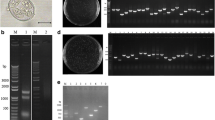Abstract
Rabbit coccidiosis is a common parasitic disease and responsible for enormous economic losses in the rabbit industry. Eimeria intestinalis, one of the highly pathogenic and common Eimeria species infecting rabbits, is considered as an indispensable species for the development of live oocyst vaccines against rabbit coccidiosis. In this study, we report the successful selection of a precocious line (EIP8) from a wild-type strain of E. intestinalis (WT) by successively collecting and propagating the early excreted progeny oocysts. The EIP8 line had a prepatent period of only 132 h compared to 204 h for the WT. Oocysts of EIP8 were notably different from those produced by the WT strain by their significantly larger size (mean length: 29.3 vs 27.6 μm and mean width 20.5 vs 19.8 μm). Examination of tissue sections prepared from EIP8-infected rabbits revealed that this precocious line undergoes only two generations of schizogony before differentiating into gametocytes by 120 h post-infection. In contrast, WT parasites undergo three generations of schizogony and gametocytes are present by 168 h post-infection. EIP8 multiplication capacity reduced by more than 35-fold and a concomitant decrease in pathogenicity was detected. Interestingly, immunization with 103 or 104 EIP8 oocysts provided sufficient protection against homologous challenge with wild-type parasites, as body weight gain of immunized and challenged rabbits was similar to that of untreated animals, as well as more than 90% reduction of oocyst output was detected in immunized and challenged animals when compared to unimmunized and challenged animals. Together, these results show that the EIP8 precocious line of E. intestinalis is an attenuated immunogenic strain and a suitable candidate for the development of a live vaccine against rabbit coccidiosis.





Similar content being viewed by others
References
Coudert P, Licois D, Streun A (1979) Characterization of Eimeria species. I. Isolation and study of pathogenicity of a pure strain of Eimeria perforans (Leuckart, 1879; Sluiter and Swellengrebel, 1912). Z Parasitenkd 59:227–234
Coudert P, Licois D, Provot F, Drouet-Viard F (1993) Eimeria sp. from the rabbit (Oryctolagus cuniculus): pathogenicity and immunogenicity of Eimeria intestinalis. Parasitol Res 79:186–190
Coudert P, Licois D, Drouet-Viard F (1995) Eimeria species and strains of the rabbits. In: Eckert J, Braun R, Shirley MW and Coudert P (eds) Guidelines on techniques in coccidiosis research. European Commission, Directorate-General XII, Science, research and development environment research programme, pp 52–73
Drouet-Viard F, Coudert P, Licois D, Boivin M (1997) Acquired protection of the rabbit (Oryctolagus cuniculus) against coccidiosis using a precocious line of Eimeria magna, effect of vaccine dose and age at vaccination. Vet Parasitol 69:197–201
El-Shahawi GA, El-Fayomi HM, Abdel-Haleem HM (2012) Coccidiosis of domestic rabbit (Oryctolagus cuniculus) in Egypt: light microscopic study. Parasitol Res 110:251–258
Jeffers TK (1975) Attenuation of Eimeria tenella through selection for precociousness. J Parasitol 61:1083–1090
Licois D, Coudert P, Boivin M, Drouet-Viard F, Provot F (1990) Selection and characterization of a precocious line of Eimeria intestinalis, an intestinal rabbit coccidium. Parasitol Res 76:192–198
Licois D, Coudert P, Bahagia S, Rossi GL (1992) Endogenous development of Eimeria intestinalis in rabbits (Oryctolagus cuniculus). J Parasitol 78:1041–1048
Licois D, Coudert P, Drouet-Viard F, Boivin M (1994) Eimeria media: selection and characterization of a precocious line. Parasitol Res 80:48–52
Licois D, Coudert P, Drouet-Viard F, Boivin M (1995) Eimeria magna: immunogenicity and selection and characterization of a precocious line. Vet Parasitol 60:27–35
Long PL, Millard BJ, Joyner LP, Norton CC (1976) A guide to laboratory techniques used in the study and diagnosis of avian coccidiosis. Folia Vet Lat 6:201–217
Pakandl M (2005) Selection of a precocious line of the rabbit coccidium Eimeria flavescens Marotel and Guilhon (1941) and characterization of its endogenous cycle. Parasitol Res 97:150–155
Pakandl M, Jelinkova A (2006) The rabbit coccidium Eimeria piriformis: selection of a precocious line and life-cycle study. Vet Parasitol 137:351–354
Pakandl M, Ahmed NE, Licois D, Coudert P (1996a) Eimeria magna Perard, 1925: study of the endogenous development of parental and precocious strains. Vet Parasitol 65:213–222
Pakandl M, Gaca K, Licois D, Coudert P (1996b) Eimeria media Kessel 1929: comparative study of endogenous development between precocious and parental strains. Vet Res 27:465–472
Pakandl M, Licois D, Coudert P (2001) Electron microscopic study on sporocysts and sporozoites of parental strains and precocious lines of rabbit coccidia Eimeria intestinalis, E. media and E. magna. Parasitol Res 87:63–66
Funding
This research was supported by China Agricultural Research System (CARS-43), the National Natural Science Foundation of China (31572507 and 31472180), and Chinese Ministry of Agriculture (948 Program: 20015-Z31).
Author information
Authors and Affiliations
Corresponding author
Ethics declarations
Experiments were approved by China Agricultural University Laboratory Animal Welfare and Animal Experimental Ethical Inspection Committee (CAU20160921-2). Animal experiments were carried out in accordance with Chinese National Laboratory Animal Standards (GB 14925-2010/XG1-2011). Enough food and water were provided. Handling of animals was minimal when they were inoculated and weighed. Fecal samplings were performed outside the rabbit cages. Rabbits were euthanized in a humane manner.
Conflict of interest
The authors declare that they have no conflict of interest.
Additional information
Section Editor: David S. Lindsay
Publisher’s note
Springer Nature remains neutral with regard to jurisdictional claims in published maps and institutional affiliations.
Rights and permissions
About this article
Cite this article
Li, C., Tao, G., Gu, X. et al. Selection and identification of a precocious line of Eimeria intestinalis with enlarged oocysts and deletion of one generation of schizogony. Parasitol Res 118, 969–976 (2019). https://doi.org/10.1007/s00436-018-06199-1
Received:
Accepted:
Published:
Issue Date:
DOI: https://doi.org/10.1007/s00436-018-06199-1




